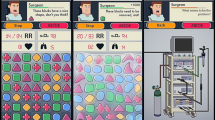Abstract
Background
This study was designed to investigate the incidence of technical equipment problems during laparoscopic procedures.
Methods
A video-capturing system was used, consisting of an analog video recorder with three camera image inputs and a microphone. Problems with all technical equipment used by the surgical team, such as the insufflator, diathermy apparatus, monitors, light source, camera and camera unit, endoscope, suction devices, and instruments, were registered.
Results
In total, 30 procedures were randomly videotaped. In 87% (26/30) of the procedures, one or more incidents with technical equipment (49 incidents) or instruments (9 incidents) occurred. In 22 of those incidents (45%) the technical equipment was not correctly positioned or not present at all; in the other 27 (55%), the equipment malfunctioned as a result of a faulty connection (9), a defect (5), or the wrong setting of the equipment (3). In 10 (20%) cases the exact cause of equipment malfunctioning was unclear.
Conclusions
The incidence of problems with laparoscopic technical equipment is high. To prevent such problems, improvement and standardization of equipment is needed, combined with the incorporation of checklist use before the start of a surgical procedure. Future research should be aimed at development, implementation, and evaluation of these measures into the operating room.




Similar content being viewed by others
References
Calland JF, Guerlain S, Adams RB, Tribble CG, Foley E, Chekan EG (2002) A systems approach to surgical safety. Surg Endosc 16: 1005–1014; discussion 1015
den Boer KT, de Wit LT, Davids PH, Dankelman J, Gouma DJ (2001) Analysis of the quality and efficiency in learning laparoscopic skills. Surg Endosc 15: 497–503
Guerlain S, Adams RB, Turrentine FB, Shin T, Guo H, Collins SR, Calland JF (2005) Assessing team performance in the operating room: development and use of a “black-box” recorder and other tools for the intraoperative environment. J Am Coll Surg 200: 29–37
Joice P, Hanna GB, Cuschieri A (1998) Errors enacted during endoscopic surgery—a human reliability analysis. Appl Ergon 29: 409–414
Kohn LT, Corrigan JM, Donaldsen MS (1999) To Err Is Human: Building a Safer Health System. National Academies Press, Washington, DC
Leape L (1994) The preventability of medical injury. In: Marilyn Sue Bogner (ed). Human Error in Medicine, Lawrence Erlbaum Associates, Hillsdale, NJ
Reason J (1990) Human Error. Cambridge University Press, New York
Reason J (2000) Human error: models and management. BMJ 320: 768–770
Sarker SK, Chang A, Vincent C, Darzi AW (2005) Technical skills errors in laparoscopic cholecystectomy by expert surgeons. Surg Endosc 19: 832–835
Sexton JB, Thomas EJ, Helmreich RL (2000) Error, stress, and teamwork in medicine and aviation: cross sectional surveys. BMJ 320: 745–749
Seymour NE, Gallagher AG, Roman SA, O’Brien MK, Andersen DK, Satava RM (2004) Analysis of errors in laparoscopic surgical procedures. Surg Endosc 18: 592–595
Tang B (2004) Analysis of technical surgical errors during initial experience of laparoscopic pyloromyoptomy by a group of Dutch pediatric surgeons. Surg Endosc 18: 1716–1720
Vincent C, Moorthy K, Sarker SK, Chang A, Darzi AW (2004) Systems approaches to surgical quality and safety: from concept to measurement. Ann Surg 239: 475–482
Xiao (2004) Introduction to the special issue on video–based research in high risk settings: methodology and experience. Cognition Technol Work 6: 127–130
Acknowledgments
Financial support for this study was provided by a national healthcare insurance company in the Netherlands (DSW, Schiedam, The Netherlands).
Author information
Authors and Affiliations
Corresponding author
Rights and permissions
About this article
Cite this article
Verdaasdonk, E.G.G., Stassen, L.P.S., van der Elst, M. et al. Problems with technical equipment during laparoscopic surgery. Surg Endosc 21, 275–279 (2007). https://doi.org/10.1007/s00464-006-0019-2
Received:
Accepted:
Published:
Issue Date:
DOI: https://doi.org/10.1007/s00464-006-0019-2




